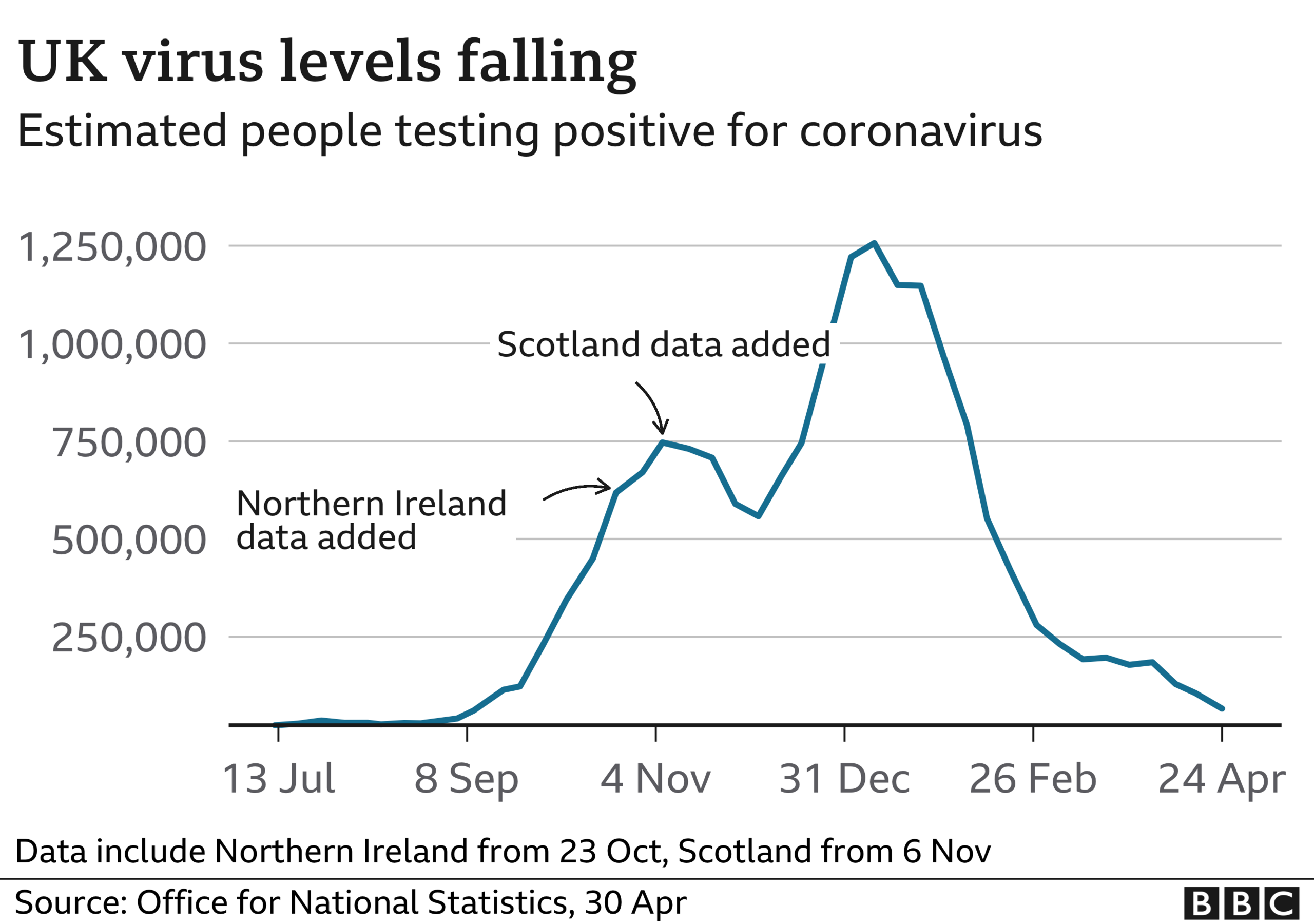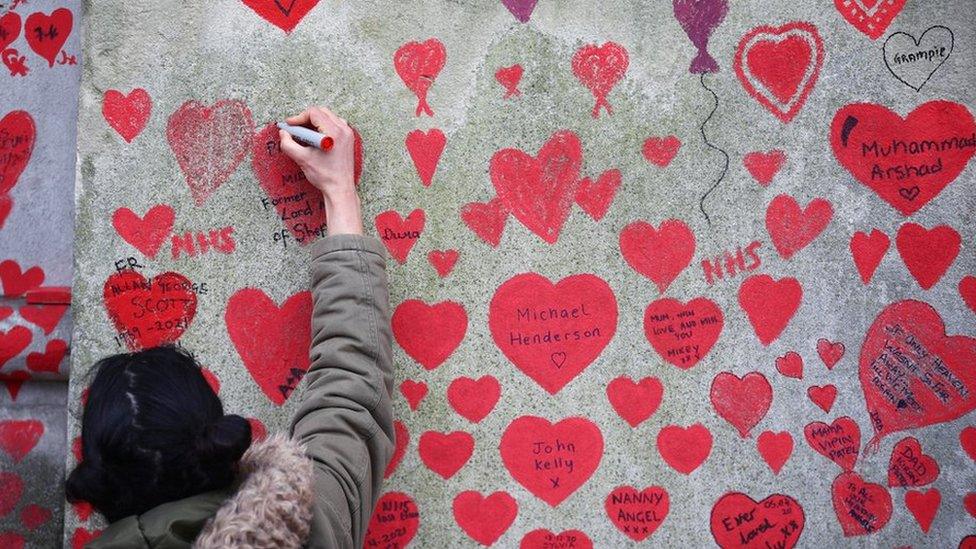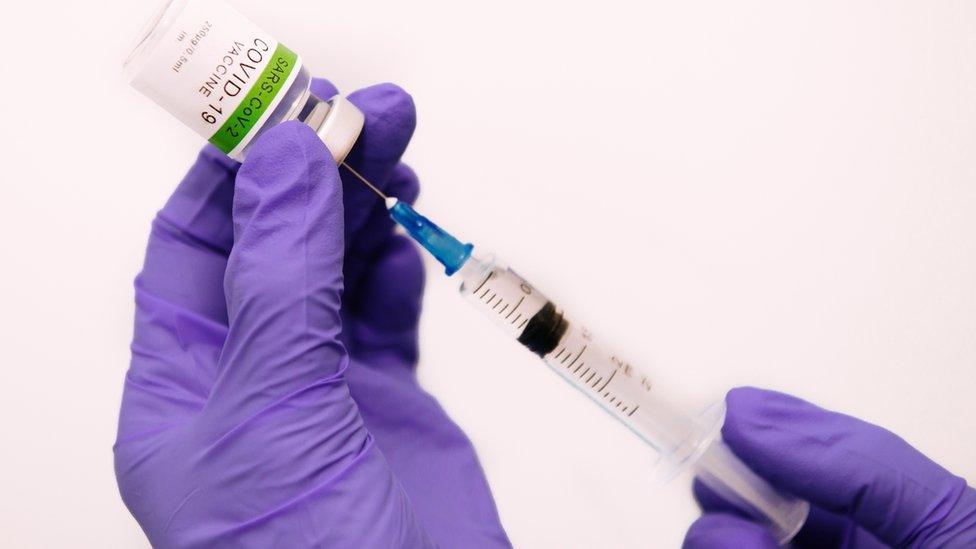Covid-19 infections in UK back to late summer levels - ONS
- Published
- comments

Coronavirus infections in the UK are back to levels seen at the end of last summer with around one in 1,000 people infected, ONS data suggests.
In the week to 24 April, infections fell in all four nations of the UK and were 20 times lower than in January.
It comes as a new UK study has found very small numbers of people have been admitted to hospital with Covid several weeks after having one vaccine dose.
More than half of the UK population has now received a first vaccine jab.
Meanwhile, BBC analysis shows about 22 million people are now living in areas where there were no Covid deaths in April.
The Office for National Statistics survey, external, which tests a random selection of thousands of people in the community, estimates that about 66,000 people in the UK would have tested positive for coronavirus in mid-April.
This is down from the previous week's estimate - and way down on the figure of 1.25 million infected at the peak of the second wave in January.
The ONS estimates that in the week to 24 April:
In England, 1 in 1,010 were infected, compared to 1 in 610 the previous week
In Wales, 1 in 1,570 were infected, compared to 1 in 840 the previous week
In Northern Ireland, 1 in 940 were infected, compared to 1 in 660 last week
In Scotland, 1 in 640 were infected, compared to 1 in 560 the week before
For England, it is the lowest figure since the week to 5 September, when the estimate stood at one in 1,400, while in Wales it is the lowest since 10 September.
In Scotland and Northern Ireland, who joined the survey later, the figures are the lowest since their estimates began.

Prof Paul Hunter, professor in medicine from the University of East Anglia, said the ONS figures confirmed the decline in daily cases across the UK and was evidence that the recent relaxation of restrictions had not had a negative impact.
"That there is in fact no evidence of an increased transmission risk is reassuring that, for the time being at least, it looks like the current roadmap is still on target," he said.
But other experts are more cautious, saying we should continue to be aware of the possible spread of variants and any changes in infection numbers.
The coronavirus reproduction number, or R value, in England is now estimated to be between 0.8 and 1.1, according to the latest government figures., external
Last week the R value, which represents the number of people each person with Covid will go on to infect, was between 0.8 and 1.0.
When the figure is above 1, an outbreak can grow exponentially, but when it is below 1, it means the epidemic is shrinking.
The Scientific Advisory Group for Emergencies (Sage) said the estimate did not necessarily mean R was definitively above 1 in some areas in England, just that the uncertainty meant it could not be ruled out.
When the number of cases falls to low levels, R estimates can be subject to large fluctuations so it is a less robust way of representing what is happening.
The UK has reported another 15 Covid-related deaths within 28 days of a positive test, and a further 2,381 new cases.
The government's latest figures, external also show 34.2 million people have now received a first dose of a vaccine, while 14.5 million people are fully vaccinated having received two jabs.
In other developments:
People aged 40 and over in England are now able to book their Covid vaccinations, the NHS has said
Queues have been forming outside shops in Northern Ireland as the latest stage of lockdown easing has seen retail open. Gyms, pubs, restaurants and cafes have also reopened after a four-month winter lockdown
Liverpool is hosting a government-organised live music event as part of a Covid safety pilot, with an audience of 3,000 people and no social distancing

NORSE MYTHOLOGY QUIZ: From Thor to Lord of the Rings, how much do you know?
DOES YOUR VOTE MATTER?: The factors that influence choices and results

Related topics
- Published30 April 2021

- Published30 April 2021

